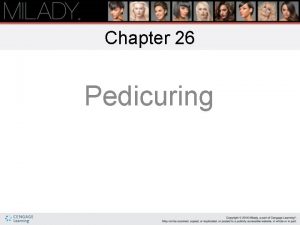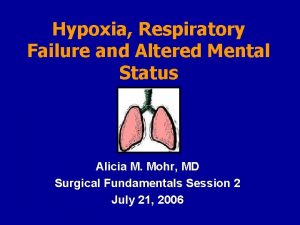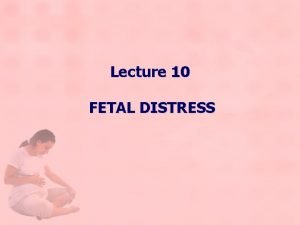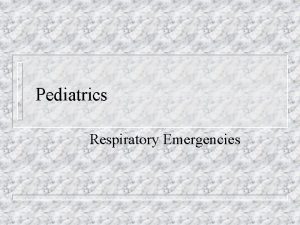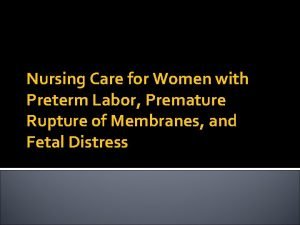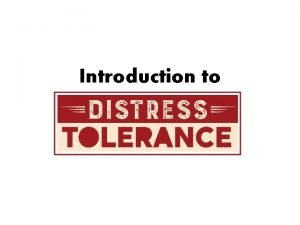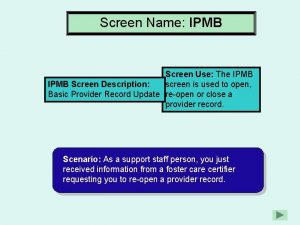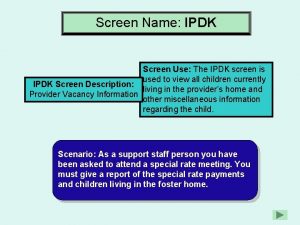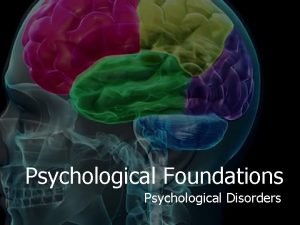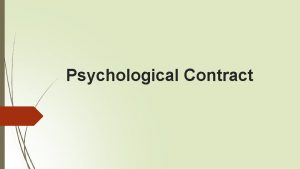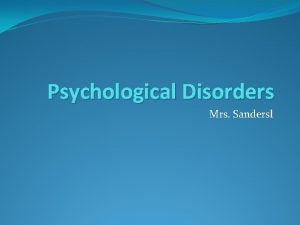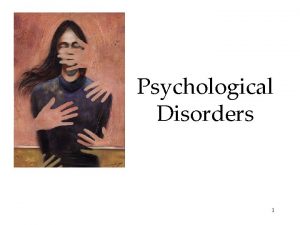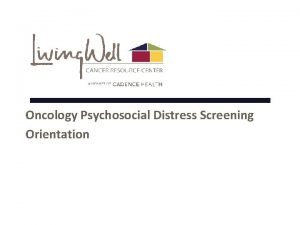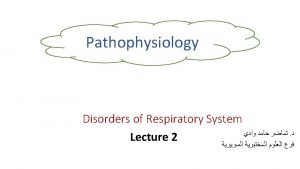Should we routinely screen for psychological distress in


























- Slides: 26

Should we routinely screen for psychological distress in the diabetes clinic? Dr Mark Davies Clinical Psychologist Belfast City Hospital

Quotes……. . Ø Initial thoughts are yes - there is inherent stress with any illness especially one in which the patient has to be so proactive in contributing to the treatment and I think a lot of patients simply cannot handle that level of stress Consultant Diabetologist

Quotes…… Ø I think screening for distress is an excellent idea but how would you propose that it is done and how long would it take and who would do it ? Consultant Diabetologist

Quotes…. . Ø How would we screen? Who would do it? Would it be new patients or a yearly test? If we uncovered a lot of 'psychological distress‘ have we the resources to do any thing about it? My experience is that a number of patients do not admit to not coping with diabetes and suffer in various ways as a result. So in an ideal world yes patients should be screened DSN

Quotes…… I think that when working with patients in the clinic that we should have sufficient awareness that patients may be distressed, that we are sensitive to the concept of such distress, receptive to the idea and if so that it should not be ignored. To assess for distress would require an instrument for screening, folk who are able to use it & then a clinical pathway to send patients along if they were found to be distressed - are these available? DSN

Psychological Distress Ø Anxiety e. g. general, needles, hypos Ø Diabetes specific ‘stress’ Ø Obsessional-compulsive disorder Ø Trauma responses Ø Personality disorder Ø Alcohol misuse Ø Drug misuse

Depression Ø Prevalence l Type 1 • Bernard et al (2006) prevalence 12% (3. 2%) l Type 2 • • • Ali et al (2006) 1. 77 increase in rate Anderson et al (2001) depression x 2 risk Peyrot & Rubin (1997) prevalence 41. 3%

How to Screen for Depression Ø Ask the patient! • Reliable but time consuming • “…a process that often takes more than one consultation and evolves in a context of trust” Kessler et al, BJGP, 2005 Ø Use a standardised assessment l e. g. PHQ-9, BDI-II, HADS, CESD, GHQ • Quick but unreliable Ø Look for signs • Quick but unreliable

Signs of Depression sleep disturbance Ø poor appetite Ø early morning wakening Ø anhedonia Ø diurnal variation Ø weight loss Ø loss of libido Ø poor concentration Ø social withdrawal Ø triad of negative cognitions Ø irritability Ø tearfulness Ø suicidal ideation Ø

Depression & Complications Ø Polonsky (1997) Longitudinal study T 2, n= 400+ Ø Over a 3 year period depression was the strongest predictor of hospitalisation Ø Over a 10 year period x 3 incidence of cardiovascular disease Ø Over a 10 year period x 3 incidence of retinopathy

What do we do? Ø Talk: psychotherapy, Cognitive Behavioural Therapy, counselling, peer support Ø Tablets: Prozac, Lustral, Zispin, Cipramil, Prothiaden, Seroxat, Efexor etc. Ø How do we decide?

Eating Disorder Ø Prevalence l l Females with type 1 are twice as likely to develop eating difficulties (Nash & Skinner, 2005) Kenardy et al (1994) 14% NIDDM (4% controls) reported binge eating Herpertz & Nielsen (2003) 20% NIDDM reported binge eating Von Mensenkampff & Davies (unpublished) 18% of newly diagnosed NIDDM females reported moderate to severe binge eating behaviour

Anorexia Nervosa Diagnostic Criteria Ø Refusal to maintain bodyweight that is normal for age and height (<15%) Ø Intense fear of becoming fat Ø Disturbance in the way body / shape/ weight is experienced Ø Absence of at least 3 consecutive menstrual cycles

Bulimia Nervosa. Diagnostic Criteria Recurrent episodes of bingeing Ø Feelings of lack of control over eating behaviour during binges Ø Self induced vomiting and/or laxative use and/or strict dieting and fasting in between episodes of bingeing to prevent weight gain (also vigorous activity). Ø Minimum of averages 2 binges per week for 3+ months Ø Persistent over-concern with body shape and weight Ø

Binge Eating Disorder Diagnostic Criteria A. Recurrent binge eating B. Associated with > 3 of the following: rapid eating, eating till too full, eating large amounts when not hungry, eating alone because of feeling low, embarrassed or disgusted C. Marked distress during binge eating D. Binge eating occurs at least 2/7 a week for 6/12 E. No regular use of compensatory behaviours NB - obesity not part of the definition

How to identify eating disorder Ø Ask the patient Ø Use a standardised assessment l e. g. Eating Attitudes Test, Eating Disorder Inventory, Binge Eating Scale Ø Look for signs

Patient characteristics Ø Low BMI Eating Disorder l l l l Female IDDM Low BMI Poorly controlled Hb. A 1 C DNAs Early onset complications esp. retinopathy Hypoglycaemia or DKA 90% cases AN/BN follows DM

Patient Characteristics Ø High BMI Eating Disorder l l l l Female NIDDM diagnosed pre-50 High BMI Weight fluctuations Emotional History of contact with MH services Majority of cases DM follows BED

Eating Disorders & Complications Ø Colas (1991) three times higher rate of retinopathy Ø Rydall et al (1997) twice the rate microalbuminuria Ø Steel at al (1987) increase in the rate of painful neuropathy

Treatment Options Ø Good evidence for CBT & IPT and BN/BED (but high drop out rate is typical) Ø Little evidence for CBT as a single treatment for AN Ø If aetiology is multifactorial then so should treatment Ø Severe AN should be referred to specialist ED service

Who should do it? § § § § General Practitioner Consultant Physician Diabetes Nurse Specialist Practise Nurse Podiatrist Dietitian Renal team Vascular team

Perceived Competence Ø Motivation l l How important is it that we screen for psychological distress and respond appropriately? How confident are you that you can do so?

What would have to change to make us more confident? Ø Depression l l l 15 - 20% will opt for anti-depressants Not everyone needs ‘therapy’ For diabetes related depression consider peer support of diabetes professional Ø Eating Disorder l l Severe AN, BN and BED refer to ED service BN and BED train dietitians in CBT

Yes because…… Ø there is a high rate of psychological distress in the population of PWD Ø Psychological distress predicts non-adherence and poorer biomedical outcomes Ø PWD see psychological and emotional support as a priority area for service development

No because… Ø Many HCPs do not feel confident about identifying psychological distress Ø Perception of having no time to screen for psychological distress Ø Reality of too few services to refer people to once the difficulties are identified

Slides available from: mark. davies@belfasttrust. hscni. net
 Pedicure toe separators target
Pedicure toe separators target Chapter 60 orthodontics
Chapter 60 orthodontics Leonard pearlin's theory of psychological distress
Leonard pearlin's theory of psychological distress Leonard pearlin theory of psychological distress
Leonard pearlin theory of psychological distress Screen small screen offscreen
Screen small screen offscreen Optimal capital structure
Optimal capital structure Featal distress
Featal distress Archetype scapegoat
Archetype scapegoat Emotional thermometer
Emotional thermometer Distress signal x1
Distress signal x1 Contoh distress
Contoh distress English paragraph
English paragraph Eustress example
Eustress example Psychology, mental health and distress
Psychology, mental health and distress Respiratory distress nasal flaring
Respiratory distress nasal flaring Tipp dbt skills
Tipp dbt skills Fetal distress definition
Fetal distress definition Respiratory distress
Respiratory distress Nst vs ctg
Nst vs ctg Pengertian psikologi klinis makro
Pengertian psikologi klinis makro Nursing care for preterm labor
Nursing care for preterm labor Navarea viii warnings
Navarea viii warnings Eustress examples for students
Eustress examples for students Suds scale thermometer
Suds scale thermometer Konsep spiritual dalam keperawatan
Konsep spiritual dalam keperawatan Moral distress and burnout
Moral distress and burnout Damsel archetype
Damsel archetype
